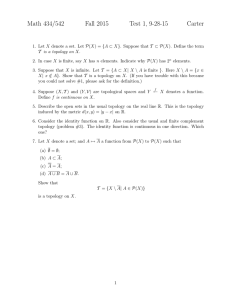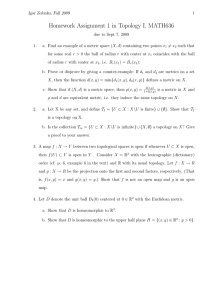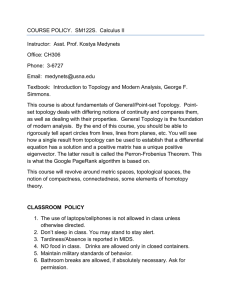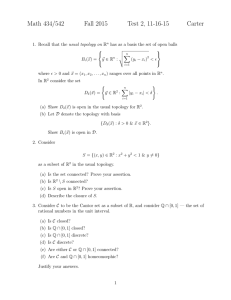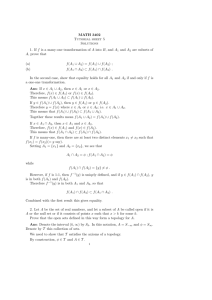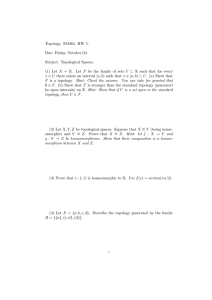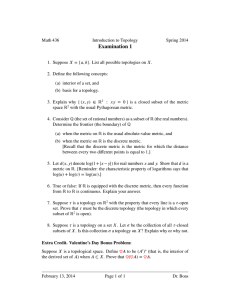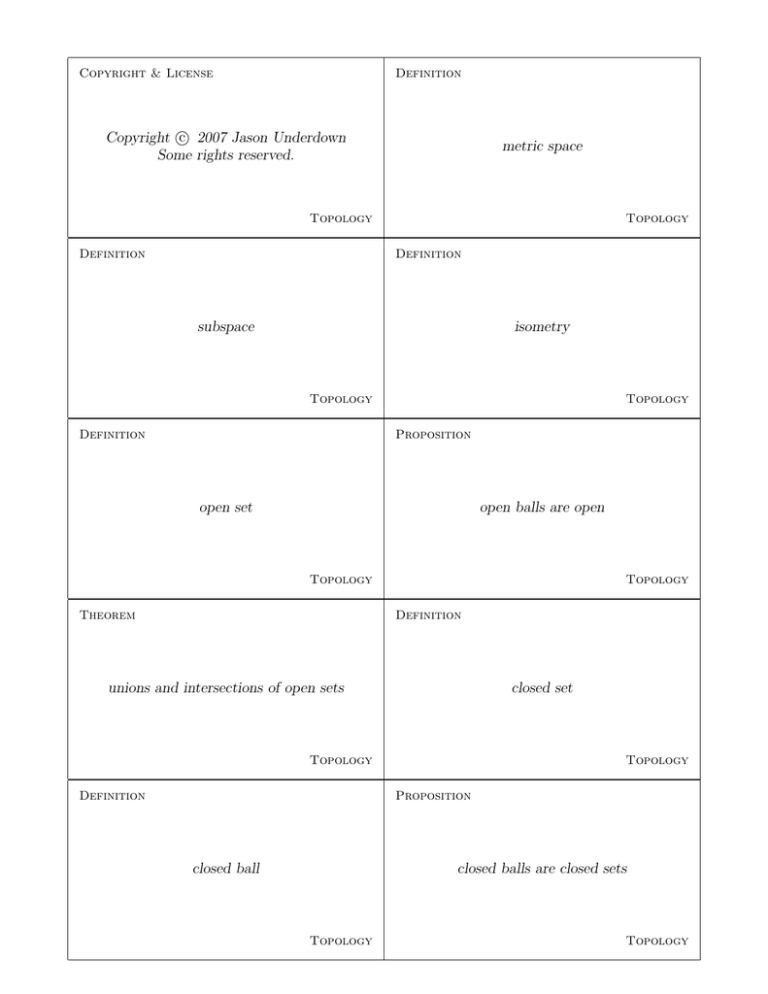
Definition
Copyright & License
c 2007 Jason Underdown
Copyright Some rights reserved.
metric space
Topology
Definition
Topology
Definition
subspace
isometry
Topology
Definition
Topology
Proposition
open set
open balls are open
Topology
Theorem
Topology
Definition
unions and intersections of open sets
closed set
Topology
Definition
Topology
Proposition
closed ball
closed balls are closed sets
Topology
Topology
A metric space (X, d) is a set X and a function
d : X × X → R satisfying ∀ x, y, z ∈ X
1. d(x, y) ≥ 0
2. d(x, y) = 0 ⇔ x = y
These flashcards and the accompanying LATEX source
code are licensed under a Creative Commons
Attribution–NonCommercial–ShareAlike 2.5 License.
For more information, see creativecommons.org. You
can contact the author at:
3. d(x, y) = d(y, x)
jasonu at physics utah edu
4. d(x, z) ≤ d(x, y) + d(y, z)
Suppose (X1 , d1 ) and (X2 , d2 ) are metric spaces. A
function f : X1 → X2 is called an isometry if f is
one–to–one, onto and
d2 (f (x), f (y)) = d1 (x, y) ∀ x, y ∈ X1
If (X, d) is a metric space, then for each x ∈ X and
for each r > 0, B(x, r) is open in X.
If (X, d) is a metric space, and A ⊂ X then (A, d|A×A )
is a metric space and is called a subspace of (X, d).
Supposing (X, d) is a metric space, then a subset U ⊂
X is open iff
∀ x ∈ U, ∃ r > 0 such that B(x, r) ⊂ U
Let (X, d) be a metric space and let {Uα }α∈A be any
collection of open sets in (X, d), then
Let (X, d) be a metric space, F ⊂ X is closed iff X −F
is open.
1. X, ∅ are open.
S
2. α∈A Uα is open.
3. Let {U1 , . .T. , Un } be a finite collection of open
n
sets, then i=1 Ui is open.
A closed ball centered at x of radius r is denoted
B(x, r), and defined to be:
A closed ball B(x, r), is a closed set.
B(x, r) = {y ∈ X | d(x, y) ≤ r}
Theorem
Definition
unions and intersections of closed sets
interior
Topology
Definition
Topology
Definition
closure
exterior & frontier
Topology
Definition
Topology
Definition
distance from a point to a set
limit of a sequence
Topology
Definition
Topology
Definition
Cauchy Sequence
convergent sequence
Topology
Theorem
Topology
Definition
convergence implies Cauchy
Topology
complete metric space
Topology
Let (X, d) be a metric space with A ⊂ X.
interior of A denoted A◦ is defined to be:
The
A◦ = {x ∈ A | ∃ r > 0 such that B(x, r) ⊂ A}
Let (X, d) be a metric space and let {Fα }α∈A be any
collection of closed sets in (X, d), then
1. X, ∅ are closed.
T
2. α∈A Fα is closed.
3. Let {F1 , . .S
. , Fn } be a finite collection of closed
n
sets, then i=1 Fi is closed.
Let (X, d) be a metric space with A ⊂ X.
The exterior of a set A is defined to be (X − A)◦ .
Let (X, d) be a metric space with A ⊂ X. The closure
of A denoted A is defined to be:
A = {x ∈ X | ∀ r > 0, B(x, r) ∩ A 6= ∅}
The frontier of a set A is defined to be A − A◦ .
Suppose (X, d) is a metric space. A sequence {xn } ⊂
X has limit x, denoted limn→∞ {xn } = x iff
∀ ε > 0, ∃ N ∈ N such that
Suppose (X, d) is a metric space with A ⊂ X and
x ∈ X. We define the distance from x to A by
d(x, A) = inf {d(x, y) | y ∈ A}
n ≥ N ⇒ xn ∈ B(x, ε)
Suppose (X, d) is a metric space. A sequence {xn } ⊂
X is called a Cauchy sequence iff
A sequence {xn } converges iff lim {xn } exits.
∀ ε > 0, ∃ N ∈ N such that
m, n ≥ N ⇒ d(xm , xn ) < ε
A metric space (X, d) is complete iff every Cauchy
sequence in X is convergent.
If a sequence {xn } is convergent then it is Cauchy.
Theorem
Theorem
limits are unique
distinct points have a radius of separation
Topology
Definition
Topology
Definition
continuous function
continuous function (alternate definition)
Topology
Definition
Topology
Theorem
Lipschitz function
Lipschitz functions are uniformly continuous
Topology
Definition
Topology
Theorem
f continuous iff
the preimage of every open set is open
bi-Lipschitz
Topology
Theorem
Topology
Definition
continuous functions and sequences
Topology
homeomorphism
Topology
Suppose (X, d) is a metric space, and x, y ∈ X with
x 6= y, then ∃ r > 0 such that B(x, r) ∩ B(y, r) = ∅
If the limit of {xn } exists, then that limit is unique.
Suppose (X1 , d1 ), (X2 , d2 ) are metric spaces. A function f : X1 → X2 is continuous on X1 iff
Suppose (X1 , d1 ), (X2 , d2 ) are metric spaces. A function f : X1 → X2 is continuous at x ∈ X1 iff
∀ x ∈ X1 , ∀ ε > 0, ∃ δ > 0 such that
∀ ε > 0, ∃ δ(x, ε) > 0 such that
f (B(x, δ)) ⊂ B(f (x), ε)
d1 (x, y) < δ ⇒ d2 (f (x), f (y)) < ε
Suppose (X1 , d1 ), (X2 , d2 ) are metric spaces. A function f : X1 → X2 is called Lipschitz iff
If f : X1 → X2 is Lipschitz on X1 , then f is uniformly
continuous on X1 .
∀ x, y ∈ X1 ∃ c > 0 such that
d2 (f (x), f (y)) ≤ cd1 (x, y)
A Lipschitz function can be thought of as a “bounded
distortion.”
A function f : X1 → X2 is continuous iff
∀ U open ⊂ X2 ⇒ f −1 (U ) open ⊂ X1
Or equivalently:
∀ U closed ⊂ X2 ⇒ f −1 (U ) closed ⊂ X1
A function f : (X1 , d1 ) → (X2 , d2 ) is called a
homeomorphism iff
1. f is continuous
2. f is 1-1 and onto
Suppose (X1 , d1 ), (X2 , d2 ) are metric spaces. A function f : X1 → X2 is called bi-Lipschitz iff
∀ x, y ∈ X1 ∃ c1 , c2 > 0 such that
c1 d1 (x, y) ≤ d2 (f (x), f (y)) ≤ c2 d1 (x, y)
A function f : (X1 , d1 ) → (X2 , d2 ) is continuous iff
∀ convergent sequences {xn } ⊂ X1 ,
lim f (xn ) = f ( lim {xn })
n→∞
3. f −1 is continous
n→∞
Definition
Remark
two metrics are equivalent iff
the identity map is a homeomorphism
equivalent metrics
Topology
Theorem
Topology
Definition
composition of continuous functions
preserves continuity
homeomorphic spaces
Topology
Definition
Topology
Definition
topology
topological space
Topology
Topology
Topology
Topology
Topology
Topology
Two metrics, d1 , d2 are equivalent iff id : (X, d1 ) →
(X, d2 ) is a homeomorphism.
Two metrics d1 , d2 are called equivalent iff they have
the same open sets.
Two metric spaces are homeomorphic iff there exists
a homeomorphism between them.
Suppose f : X1 → X2 and g : X2 → X3 . If f and g
are continuous then g ◦ f is continuous.
Suppose X is a set. A collection τ of subsets of X is
called a topology on X iff
1. X ∈ τ and ∅ ∈ τ
A topological space (X, τ ) is a set X and a topology
τ on X.
2. Uα ∈ τ for α ∈ A ⇒
[
Uα ∈ τ
α∈A
3. U1 , U2 , . . . , Un ∈ τ ⇒
∞
\
i=1
Ui ∈ τ

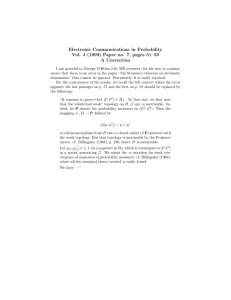
![MA342A (Harmonic Analysis 1) Tutorial sheet 2 [October 22, 2015] Name: Solutions](http://s2.studylib.net/store/data/010415895_1-3c73ea7fb0d03577c3fa0d7592390be4-300x300.png)
